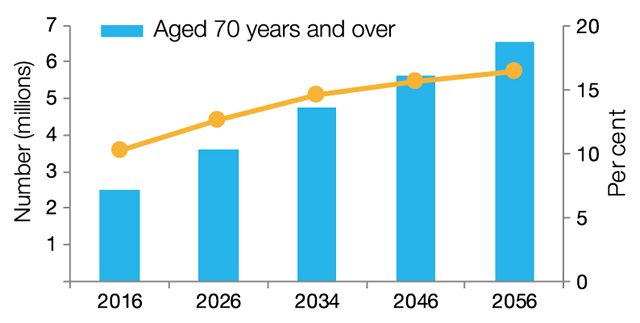Alex Grove, Social
Policy
|
|
Key Issue
Demand for aged care is growing as the population ages, with a corresponding increase in Australian Government expenditure.
Aged care issues look set to feature strongly in the 45th Parliament. A review of recent reforms will be conducted and tabled in parliament, major changes to home care will commence in 2017, and further reforms have already been foreshadowed. |
Increasing demand for aged care
The Australian Government is the primary source of funds
for, and regulator of, the aged
care system. Care is provided in people’s homes or in a residential
(nursing home) setting by more
than 2,000 not-for-profit, for-profit and government providers.
Recurrent
government expenditure on aged care services was around $15.8 billion in
2014–15, with the Australian Government providing approximately 95 per cent of
this funding. Expenditure is contained by capping the number of subsidised aged care places in line with growth in the population aged 70
years or over (aged care services are generally aimed at people aged 65 or over,
but the average
age of consumers is considerably older). As the figure below shows, the
number of people aged 70 years and over is projected to grow from 2.5 million
in 2016 to 3.6 million in 2026, requiring more subsidised places. In the longer
term, demand
for aged care services is expected to more than treble by 2056.
Figure 1: Number and proportion of the population
aged 70 and over

Source: Australian Bureau of Statistics, Population
Projections (Series B), 2013.
Review of the 2012 reforms
The Productivity Commission (PC) released a report in 2011
recommending significant
changes to the aged care system to improve access, quality and choice of
services, and financial sustainability. The then Labor Government incorporated
some of the PC’s recommendations in its 2012 Living
Longer. Living Better (LLLB) reform package. The first
wave of LLLB reforms required consumers to contribute equitably to the cost
of their care and accommodation, placed a greater focus on individualised care
and established the My Aged Care
website and call centre to help people navigate the system. The longer term
goal was to create a more flexible and integrated aged care system driven by
consumer choice, with less government regulation.
The LLLB reforms are now due for review. The legislation (section
4) requires an independent review commencing around August 2016 to be tabled in
parliament in 2017. The review will consider matters such as demand for and
supply of places, means testing, pricing, access, and workforce strategies. It may
also consider issues
that have emerged since the reforms were enacted, such as the recent tightening
of the funding formula for residential aged care providers.
Changes to care in the home
Significant
changes to aged care services provided to people in their homes are set to
commence in 2017. From 27 February 2017, packages
of home care services will be allocated directly to eligible consumers.
This means that consumers will no longer have to search for a provider that has
a package available in their area, as they will be able to direct the funding
attached to their package to a provider of their choice. While this should
increase consumer choice and market competition, questions
have been raised about the capacity of consumers to make an informed choice
if their decision-making capacity is reduced, or if comparative information on
providers is not readily available. The changes to home care may also focus
attention on unmet demand, as a national waiting list for home care packages
will be created for the first time.
Further changes to home care were flagged in the 2015–16
Budget, with a proposal to merge home care packages with the entry level Commonwealth
Home Support Programme from 2018. Legislation for the proposed merger has
not yet been introduced, but may come before the 45th Parliament for
consideration.
Calls for further reform
Aged care stakeholders look set to campaign for
further structural reform of the aged care system during the 45th
Parliament. In April 2016, the Aged
Care Sector Committee produced a Roadmap
at the request of then Assistant Minister for Social Services, Mitch Fifield,
calling for wide-ranging changes to make the system more sustainable, consumer-driven
and market-based. This included
some proposals that were recommended
by the PC in 2011 but not adopted by government, such as uncapping
the number of subsidised places, and releasing equity in the family home to
pay for aged care. Such proposals could come with a degree of fiscal or
political risk.
It is likely that aged
care workforce issues including employee remuneration and retention, and
whether workforce growth will be able to keep pace with rising demand for
services, will continue to be a focus for the Parliament. The Senate
inquiry into the future of Australia’s aged care sector workforce did not
report prior to the dissolution of parliament, and may
resume its inquiry in 2016.
The aged care system has undergone significant
reforms since 2012. Given the increasing demand for services, ongoing cost and
workforce pressures, and stakeholder calls for further reform, this rapid pace
of change is expected to continue during the 45th Parliament.
Further reading
A Grove, ‘Aged Care Roadmap: a guide to the future of aged care?’, FlagPost, Parliamentary Library blog, 12 May 2016.
A Grove, Aged Care Legislation Amendment (Increasing Consumer Choice) Bill 2016, Bills digest, 94, 2015–16, Parliamentary Library, Canberra, 2016.
Back to Parliamentary Library Briefing Book
For copyright reasons some linked items are only available to members of Parliament.
© Commonwealth of Australia

Creative Commons
With the exception of the Commonwealth Coat of Arms, and to the extent that copyright subsists in a third party, this publication, its logo and front page design are licensed under a Creative Commons Attribution-NonCommercial-NoDerivs 3.0 Australia licence.